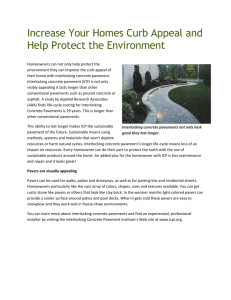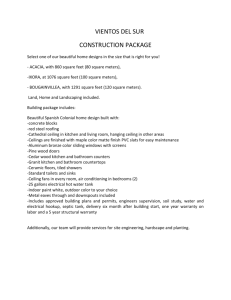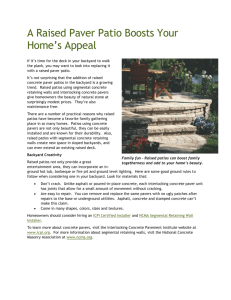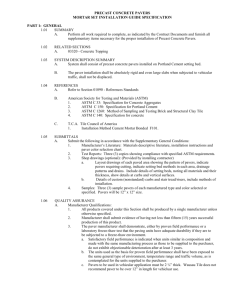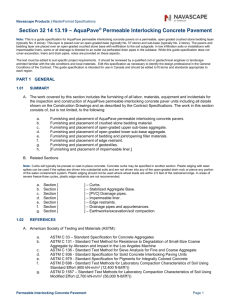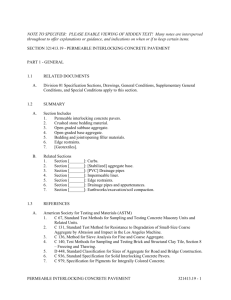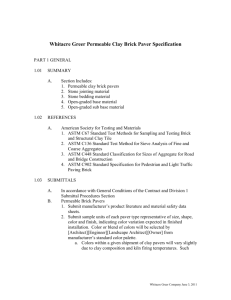Grading Requirements for Bedding, Base and Sub-base
advertisement
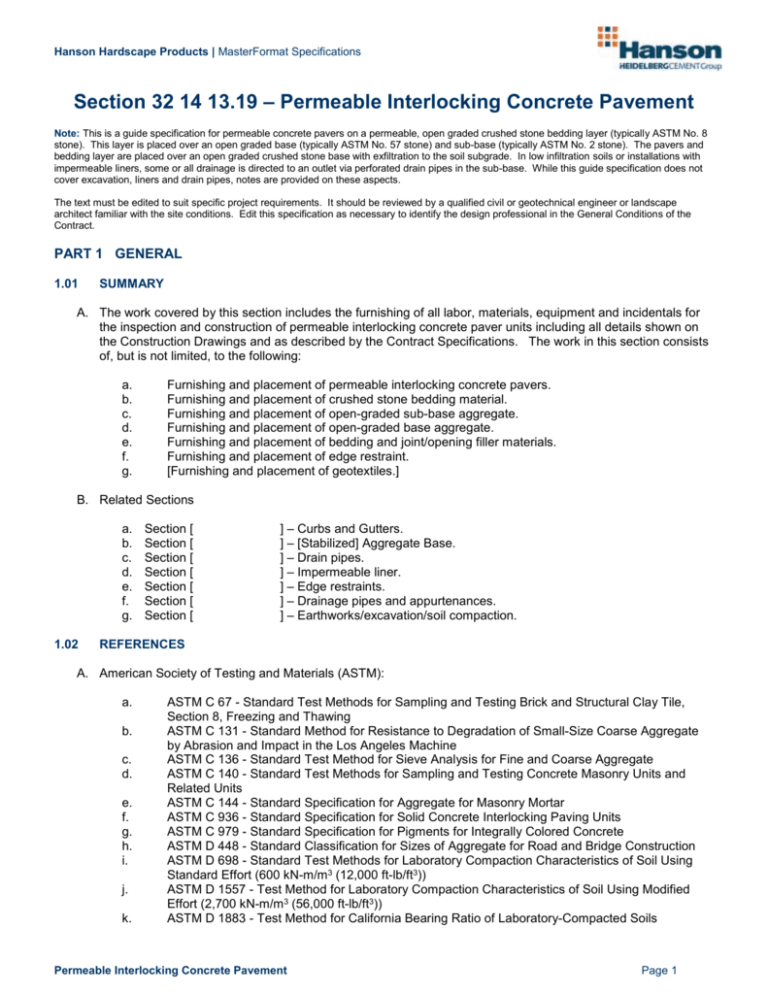
Hanson Hardscape Products | MasterFormat Specifications Section 32 14 13.19 – Permeable Interlocking Concrete Pavement Note: This is a guide specification for permeable concrete pavers on a permeable, open graded crushed stone bedding layer (typically ASTM No. 8 stone). This layer is placed over an open graded base (typically ASTM No. 57 stone) and sub-base (typically ASTM No. 2 stone). The pavers and bedding layer are placed over an open graded crushed stone base with exfiltration to the soil subgrade. In low infiltration soils or installations with impermeable liners, some or all drainage is directed to an outlet via perforated drain pipes in the sub-base. While this guide specification does not cover excavation, liners and drain pipes, notes are provided on these aspects. The text must be edited to suit specific project requirements. It should be reviewed by a qualified civil or geotechnical engineer or landscape architect familiar with the site conditions. Edit this specification as necessary to identify the design professional in the General Conditions of the Contract. PART 1 GENERAL 1.01 SUMMARY A. The work covered by this section includes the furnishing of all labor, materials, equipment and incidentals for the inspection and construction of permeable interlocking concrete paver units including all details shown on the Construction Drawings and as described by the Contract Specifications. The work in this section consists of, but is not limited, to the following: a. b. c. d. e. f. g. Furnishing and placement of permeable interlocking concrete pavers. Furnishing and placement of crushed stone bedding material. Furnishing and placement of open-graded sub-base aggregate. Furnishing and placement of open-graded base aggregate. Furnishing and placement of bedding and joint/opening filler materials. Furnishing and placement of edge restraint. [Furnishing and placement of geotextiles.] B. Related Sections a. b. c. d. e. f. g. 1.02 Section [ Section [ Section [ Section [ Section [ Section [ Section [ ] – Curbs and Gutters. ] – [Stabilized] Aggregate Base. ] – Drain pipes. ] – Impermeable liner. ] – Edge restraints. ] – Drainage pipes and appurtenances. ] – Earthworks/excavation/soil compaction. REFERENCES A. American Society of Testing and Materials (ASTM): a. b. c. d. e. f. g. h. i. j. k. ASTM C 67 - Standard Test Methods for Sampling and Testing Brick and Structural Clay Tile, Section 8, Freezing and Thawing ASTM C 131 - Standard Method for Resistance to Degradation of Small-Size Coarse Aggregate by Abrasion and Impact in the Los Angeles Machine ASTM C 136 - Standard Test Method for Sieve Analysis for Fine and Coarse Aggregate ASTM C 140 - Standard Test Methods for Sampling and Testing Concrete Masonry Units and Related Units ASTM C 144 - Standard Specification for Aggregate for Masonry Mortar ASTM C 936 - Standard Specification for Solid Concrete Interlocking Paving Units ASTM C 979 - Standard Specification for Pigments for Integrally Colored Concrete ASTM D 448 - Standard Classification for Sizes of Aggregate for Road and Bridge Construction ASTM D 698 - Standard Test Methods for Laboratory Compaction Characteristics of Soil Using Standard Effort (600 kN-m/m3 (12,000 ft-lb/ft3)) ASTM D 1557 - Test Method for Laboratory Compaction Characteristics of Soil Using Modified Effort (2,700 kN-m/m3 (56,000 ft-lb/ft3)) ASTM D 1883 - Test Method for California Bearing Ratio of Laboratory-Compacted Soils Permeable Interlocking Concrete Pavement Page 1 Hanson Hardscape Products | MasterFormat Specifications l. ASTM D 4254 - Standard Test Methods for Minimum Index Density and Unit Weight of Soils and Calculation for Relative Density B. Canadian Standards Association (CSA): a. CSA A231.2 - Precast Concrete Pavers C. Interlocking Concrete Pavement Institute (ICPI) a. 1.03 Permeable Interlocking Concrete Pavement Manual SUBMITTALS A. In accordance with Conditions of the Contract and Division 1 Submittal Procedures Section. B. Manufacturer’s drawings and details: Indicate perimeter conditions, relationship to adjoining materials and assemblies, [expansion and control joints], concrete paver [layout], [patterns], [color arrangements], and installation and [setting] details. C. Minimum 2 kg (4 lbs) sample of sub-base, base and bedding aggregate materials. D. Sieve analysis per ASTM C136 for sub-base, base and bedding aggregate materials. E. Soils report indicating density test reports, classification, and infiltration rate measured on site under compacted conditions, and suitability for the intended project. F. Erosion and sediment control plan. G. [Storm water management (quality and quantity) calculations.] H. Permeable Concrete Pavers: a. b. c. d. e. f. I. Paver Installation Subcontractor: a. b. c. 1.04 Manufacturer’s catalog sheets with specifications. [Four] representative full-size samples of each paver type, thickness, color, finish that indicate the range of color variation and texture expected in the finished installation. Color(s) selected by [Architect] [Engineer] [Landscape Architect] [Owner] from manufacturer’s available colors. Accepted samples become the standard of acceptance for the work. Test results from an independent testing laboratory for compliance of concrete pavers with [CSA A231.2] [ASTM C936] Manufacturer’s material safety data sheets for the safe handling of the specified materials and products. Manufacturer’s written quality control procedures including representative samples of production record keeping that ensure conformance of paving products to the project specifications. A copy of Subcontractor’s current certificate from the Interlocking Concrete Pavement Institute Concrete Paver Installer Certification program. Job references from projects of a similar size and complexity. Provide Owner/Client/General Contractor names, postal address, phone, fax, and email address. Written Method Statement and Quality Control Plan that describes material staging and flow, paving direction and installation procedures, including representative reporting forms that ensure conformance to the project specifications. QUALITY ASSURANCE A. Paving Subcontractor Qualifications: Permeable Interlocking Concrete Pavement Page 2 Hanson Hardscape Products | MasterFormat Specifications a. Utilize an installer having successfully completed concrete paver installation similar in design, material, and extent indicated on this project. b. Utilize an installer holding a current certificate from the Interlocking Concrete Pavement Institute Concrete Paver Installer Certification program. B. Regulatory Requirements and Approvals: [Specify applicable licensing, bonding or other requirements of regulatory agencies.]. C. Review the manufacturer’s quality control plan, paver installation subcontractor’s Method Statement and Quality Control Plan with pre-construction meeting of representatives from the manufacturer, paver installation subcontractor, general contractor, engineer and/or owner’s representative. D. Mock-Ups: a. Install a 3 m x 3 m [10 ft x 10 ft] paver area. b. Use this area to determine surcharge of the bedding layer, joint sizes, lines, laying pattern(s), color(s), and texture of the job. c. This area will be used as the standard by which the work will be judged. d. Subject to acceptance by owner, mock-up may be retained as part of finished work. e. If mock-up is not retained, remove and properly dispose of mock-up. 1.05 DELIVERY, STORAGE AND HANDLING A. General: Comply with Division 1 Product Requirement Section. B. Comply with manufacturer’s ordering instructions and lead-time requirements to avoid construction delays. C. Delivery: Deliver materials in manufacturer’s original, unopened, undamaged containers packaging with identification labels intact. a. Coordinate delivery and paving schedule to minimize interference with normal use of buildings adjacent to paving. b. Deliver concrete pavers to the site in steel banded, plastic banded or plastic wrapped packaging capable of transfer by forklift or clamp lift. c. Unload pavers at job site in such a manner that no damage occurs to the product. D. Storage and Protection: Store materials protected such that they are kept free from mud, dirt, and other foreign materials. 1.06 PROJECT/SITE CONDITIONS A. Environmental Requirements: a. b. c. d. 1.07 Do not install in rain or snowfall. Do not install over frozen base or sub-base materials. Do not install frozen base material. Do not install pavers on frozen bedding material. MAINTENANCE A. Extra Materials: Provide [Specify area, percentage] additional material for use by owner for maintenance and repair. B. Pavers shall be from the same production run as installed materials. PART 2 PRODUCTS 2.01 INTERLOCKING CONCRETE PAVERS Permeable Interlocking Concrete Pavement Page 3 Hanson Hardscape Products | MasterFormat Specifications Note: Some projects may include permeable and solid interlocking concrete pavements. Specify each product as required. A. Manufacturer: a. Hanson Hardscape Products: RR#2, 1081 Rife Road, Cambridge ON N1R 5S3, Ph: 800 265 6496 b. Hanson Hardscape Products: 7447 Bren Road, Mississauga, ON L4T 1H3, Ph: 800 562 8490 c. Hanson Hardscape Products: 12898 Mack Avenue, Cement City, MI 49233, Ph: 800 447 5898 B. Permeable Interlocking Concrete Paver Units: a. Paver Type: [Specify name of product group, family, series, etc.] Note: Concrete pavers may have spacer bars on each unit. They are recommended for mechanically installed pavers and for those in heavy vehicular traffic. Manually installed pavers may be installed with or without spacer bars. Verify with manufacturers that overall dimensions do or do not include spacer bars. C. Material Standards: a. Meet the following physical requirements set forth in CSA-A231.2, Precast Concrete Pavers: i. Average compressive strength of cubes cut from five pavers to be greater than 50 MPa with no individual cube below 45 MPa when tested in accordance with CSA A231.2. ii. Average loss of three full size pavers less than 225 g/m 2 after 28 freeze-thaw cycles or 500 g/m2 after 49 freeze-thaw cycles immersed in a 3% saline solution when tested in accordance with CSA A231.2. OR a. Meet the following physical requirements set forth in ASTM C 936 Standard Specification for Solid Concrete Interlocking Paving Units; i. Average compressive strength of three pavers to be greater than 8000 psi with no individual unit under 7250 psi when tested in accordance with ASTM C140. ii. Average absorption of three pavers to be less than 5% with no unit greater than 7% when tested in accordance with ASTM C 140. iii. Maximum 1.0 % weight loss of five specimens subjected to 50 freeze-thaw cycles when tested in accordance with ASTM C 67. Note: When 80 mm (3 1/8”) thick pavers are specified, their compressive strength test results per ASTM C140 should be adjusted by multiplying by 1.18 to equate the results to that from 60 mm (2 3/8”) thick pavers. 2.02 PRODUCT SUBSTITUTIONS A. Substitutions: No substitutions permitted. 2.03 CRUSHED STONE FILLER, BEDDING, BASE AND SUB-BASE A. Provide crushed stone with 90% fractured faces, LA Abrasion < 40 per ASTM C131, minimum CBR of 80% per ASTM D1883. B. Do not use rounded river gravel. C. All stone materials shall be washed with less than 1% passing No. 200 sieve. D. Joint/opening filler, bedding, base and sub-base: conforming to ASTM D448 gradation as shown in Table 1 below: Note: No. 89 or finer gradation may be used to fill permeable pavers with narrow joints. Table 1 Grading Requirements for Bedding, Base and Sub-base ASTM No. 8 – Bedding ASTM No. 57 – Base ASTM No. 2 – Sub-base Material Material Material Permeable Interlocking Concrete Pavement Page 4 Hanson Hardscape Products | MasterFormat Specifications Sieve Size 3 in. (75 mm) 2 1/2 in. (63 mm) 2 in. (50 mm) 1 1/2 in. (37.5 mm) ¾ in. (19 mm) ½ in. (12.5 mm) 3/8 in. (9.5 mm) No. 4 (4.75 mm) No. 8 (2.36 mm) No. 16 (1.18 mm) Percent Passing Percent Passing 100 85 to 100 10 to 30 0 to 10 0 to 5 100 95 to 100 25 to 60 100 90 to 100 35 to 70 0 to 15 0 to 5 0 to 10 0 to 5 Note: Dx is the particle size at which x percent of the particles are finer. For example D15 is the particle size of the aggregate for which 15% of the particles are smaller and 85% are larger. E. Gradation criteria for the bedding and base: a. D15 base stone / D50 bedding stone < 5. b. D50 base stone / D50 bedding stone > 2. Note: Curbs will typically be cast in place concrete or precast set in concrete haunches. Concrete curbs may be specified in another Section. Do no use plastic edging with steel spikes to restrain paving units. 2.04 ACCESSORIES A. Provide accessory materials as follows: a. Edge restraints: i. Manufacturer: [Specify manufacturer] ii. Material: [Specify material] iii. Material Standards: [Specify material standards] b. Geotextile Fabric: i. Material Type and Description: [Specify material type and description.] ii. Material Standards: [Specify material standard] iii. Manufacturer: [Acceptable to interlocking concrete paver manufacturer] [Specify manufacturer]. PART 3 EXECUTION 3.01 ACCEPTABLE INSTALLERS A. [Specify acceptable paving subcontractors] 3.02 EXAMINATION Note: The elevations and surface tolerance of the soil subgrade determine the final surface elevations of concrete pavers. The paver installation contractor cannot correct deficiencies in the base surface with additional bedding materials or by other means. Therefore, the surface elevations of the base should be checked and accepted by the General Contractor or designated party, with written certification to the paving subcontractor, prior to starting work. A. Acceptance of Site Verification of Conditions: a. General contractor shall inspect, accept and certify in writing to the paver installation subcontractor that site conditions meet specifications for the following items prior to installation of interlocking concrete pavers. Note: Compaction of the soil subgrade should be determined by the project engineer. If the soil subgrade requires compaction, compact to a minimum 95% standard Proctor density per ASTM C698. Compacted soil density and moisture should be checked in the field with a nuclear density gauge or other test methods for compliance to specifications. Stabilization of the soil and/or base material may be necessary with weak or Permeable Interlocking Concrete Pavement Page 5 Hanson Hardscape Products | MasterFormat Specifications continually saturated soils, or when subject to high wheel loads. Compaction will reduce the permeability of the soil. If soil compaction is necessary, reduced infiltration may require drain pipes within the open-graded sub base to conform to local storm drainage requirements. i. ii. iii. iv. Verify that subgrade preparation, compacted density and elevations conform to the specified requirements. Verify the geotextiles, if applicable, have been placed according to the drawings and specifications. Provide written density test results for soil sub-grade to the Owner, General Contractor and paver installation subcontractor. Verify location, type, and elevations of edge restraints, [concrete collars around] utility structures, and drainage pipe and inlets. b. Do not proceed with installation of bedding sand and interlocking concrete pavers until sub-grade soil conditions are corrected by the General Contractor or designated subcontractor. 3.03 PREPARATION A. Verify soil sub-grade is free from standing water. B. Stockpile join/opening filler, base and sub-base materials such that they are free from standing water, uniformly graded, free of organic material or sediment, debris, and ready for placement. C. Edge Restraint Preparation: a. Install edge restraints per the drawings at the indicated elevations. 3.04 INSTALLATION Note: The minimum slope of the soil sub-grade should be 0.5%. Actual slope of soil subgrade will depend on the drainage design and exfiltration type. All drain pipes, observation wells, overflow pipes, geotextile (if applicable) and impermeable liner (if applicable)should be in place per the drawings prior or during placement of the sub-base and base depending on their location. Care must be taken not to damage drain pipes during compaction and paving. No mud or sediment can be left on the base or bedding aggregates. If they are contaminated, they must be removed and replaced with clean materials. A. General: a. Any excess thickness of soil applied over the excavated soil sub-grade to trap sediment from adjacent construction activities shall be removed before application of the [geotextile] and sub-base materials. b. Keep area where pavement is to be constructed free from sediment during entire project. [Geotextiles] Base and bedding materials contaminated with sediment shall be removed and replaced with clean materials. c. Do not damage drainpipes, overflow pipes, observation wells, or any inlets and other drainage appurtenances during installation. Report any damage immediately to the project engineer. B. Geotextiles: a. Place on [bottom and] sides of soil subgrade. Secure in place to prevent wrinkling from vehicle tires and tracks. b. Overlap a minimum of [300 mm (12”)] [600 mm (24”)] in the direction of drainage. C. Open-graded sub-base and base: a. Moisten, spread and compact the No. 2 sub-base in 100 to 150 mm (4 to 6”) lifts [without wrinkling or folding the geotextile. Place sub-base to protect geotextile from wrinkling under equipment tires and tracks.] b. For each lift, make at least two passes in the vibratory mode then at least two in the static mode with a minimum 10 T (10 t) vibratory roller until there is no visible movement of the No. 2 stone. Do not crush aggregate with the roller. c. The surface tolerance of the compacted No. 2 subbase shall be +/- 65 mm (2 ½”) over a 3 m (10 ft) straight edge. Permeable Interlocking Concrete Pavement Page 6 Hanson Hardscape Products | MasterFormat Specifications d. Moisten, spread and compact No. 57 base in 100 mm (4”) lift over the compacted No. 2 sub-base with a minimum 10 T (10 t) vibratory roller until there is no visible movement of the No. 57 stone. Do not crush aggregate with the roller. e. The surface tolerance of the compacted No. 57 base should not deviate more than +/- 25 mm (1”) over a 3 m (10 ft) straightedge. Note: In place density of the base and sub-base may be checked per ASTM D 4254. Compacted density should be 95% of the laboratory index density established for the base and sub-base. D. Bedding layer: a. Moisten, spread and screed the No. 8 stone bedding material. b. Fill voids left by removed screed rails with No. 8 stone. c. The surface tolerance of the screeded No. 8 bedding layer shall be +/- 10 mm (3/8”) over a 3 m (10 ft) straightedge. d. Do not subject screeded bedding material to any pedestrian or vehicular traffic before unit paving installation begins. E. Permeable interlocking concrete pavers and joint/opening fill material: a. Lay the pavers in the pattern(s) and joint widths as shown on the drawings. Maintain straight pattern lines. b. Fill gaps at the edges of the paved area with cut pavers or edge units. All cut pavers exposed to vehicular tires shall be no smaller than one third of a whole paver. c. Cut pavers to be placed along the edge with masonry saw. d. Fill the openings and joints with No. 8 stone. Note: Some paver joint widths may be narrow and not accept most of the No. 8 stone. Use joint material that will fill the joints such as washed ASTM No. 9 or No. 10 stone. These smaller stone sizes are recommended for filling joints in pedestrian applications that use 60 mm (2 3/8”) pavers. e. Remove excess aggregate on the surface by sweeping pavers clean. f. Compact and seat the pavers into the bedding material using a low amplitude plate compactor capable of at least 18 kN (4000 lbf) compaction at a frequency of 75 hz – 90 hz. This will require at least two passes with the plate compactor. g. Do not compact within 2 m (6 ft) of the unrestrained edges of the paving units. h. Apply additional aggregate to the openings and joints, filling them completely. Remove excess aggregate by sweeping then compact the pavers. This will require at least two passes with the plate compactor. i. All pavers within 2 m (6 ft) of the laying face must be left fully compacted at the completion of each day. j. The final surface tolerance of compacted pavers shall not deviate more than +/- 10 mm (3/8”) under a 3 m (10 ft) long straightedge. k. The surface elevation of pavers shall be 3 to 6 mm (1/8 to ¼”) above adjacent drainage inlets, concrete collars or channels. 3.05 FIELD QUALITY CONTROL A. After sweeping the surface clean, check final elevations for conformance to the drawings. B. Lippage: No greater than 3 mm (1/8”) difference in height between adjacent pavers. Note: The minimum slope of the finished pavement surface should be 1%. The surface of the pavers may be 3 to 6 m (1/8 to ¼”) above the final elevations after compaction. This helps compensate for minor settling normal to pavements. 3.06 PROTECTION A. After work in this section is complete, the General Contractor shall be responsible for protecting work from sediment deposition and damage due to subsequent construction activity on site. Permeable Interlocking Concrete Pavement Page 7 Hanson Hardscape Products | MasterFormat Specifications END OF SECTION Permeable Interlocking Concrete Pavement Page 8

